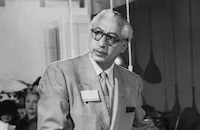Angel in My Pocket
Brief Synopsis
Cast & Crew
Alan Rafkin
Andy Griffith
Jerry Van Dyke
Kay Medford
Lee Meriwether
Henry Jones
Film Details
Technical Specs

Synopsis
Samuel D. Whitehead, a newly ordained minister who put himself through seminary school by working in a brickyard, is assigned to his first parish in the small town of Wood Falls, Kansas. For years, the town has been beset by the endless bickering of the two founding families, the Sinclairs and the Greshams, and the church has had seven other ministers in the past decade. Upon arriving with his pregnant wife, Mary Elizabeth, his three small children, his complaining mother-in-law, Racine, and his shiftless brother-in-law Bubba, Sam's troubles begin immediately. First, he becomes involved in a sidewalk political brawl between the supporters of Mayor Will Sinclair and his opponent, Axel Gresham. Next, his visit to a burlesque house to arrange for the donation of its unused organ to the church is misinterpreted, and, finally, he performs the marriage ceremony for Lila Sinclair and Norman Gresham, a middle-aged couple who have kept their love a secret for 25 years because of their feuding families. Although Sam plans to keep the wedding a secret, it becomes public knowledge when Bubba and the parsonage caretaker, Calvin Grey, spike the church social punch with liquor made in the basement, and the normally shy Lila blurts out the news. After Will Sinclair and Axel Gresham arrange for Sam to be removed, Sam persuades a young lawyer, Art Shields, to run for mayor. The parades of all three candidates meet on the main street, and the ensuing chaos ends when the distillery explodes, setting the church on fire. As word arrives that Shields has won the election, Sam leaves town with his family, but his car is stopped by a procession led by Sinclair and Gresham. Reconciled and united by their defeat in the mayoral race, they are going to build a new church, and they ask Sam to remain as pastor. Mary Elizabeth announces that she is about to give birth to her fourth child, and Sam shouts his acceptance, turning his car back toward Wood Falls.

Director

Alan Rafkin
Cast

Andy Griffith
Jerry Van Dyke

Kay Medford
Lee Meriwether

Henry Jones

Edgar Buchanan
Gary Collins
Parker Fennelly
Jack Dodson
Elena Verdugo

Margaret Hamilton

Ruth Mcdevitt
Richard Van Fleet
Bob Hastings
Jim Boles
Leonard Stone
Steve Franken
Larry D. Mann
Al Checco
Margaret Ann Peterson
Peggy Mondo
Beverly Powers
Joy Harmon

Benny Rubin
Herbie Faye
George Tapps

Eddie Quillan
Michael Barrier
Buddy Foster
Todd Starke
Amber Smale
Susan Seaforth
Athena Lorde
Grace Albertson
Robert Lieb
Claudia Bryar
Tani Phelps
Monty Margetts
Eve Bruce
Lynn Fields
Gloria Mills
Chela Bacigalupo
Anne Besant
Linda Carol
Bonnie Sue Schwartz
Jesslyn Fax
Stuart Nisbet

Ellen Corby
Kathryn Minner
Mary Gregory
Rufe Davis
Crew
Dave Blume
Phil Bowles
Jim Fritzell
Larry Germain
Joseph Gershenson
Alexander Golitzen
Everett Greenbaum
Grady Hunt
Jerry Keller
Russell Kimball
William Margulies
John Mccarthy Jr.
Edward J. Montagne
Lyn Murray
Billy Sands
Ed Somers
John Sturtevant
Wes Thompson
Waldon O. Watson
Sam E. Waxman
Bud Westmore

Film Details
Technical Specs

Articles
Angel in My Pocket -
Directed by Alan Rafkin and produced by Edward Montagne, Angel in My Pocket co-starred Lee Meriwether as Griffith's wife, Jerry Van Dyke as his trouble-making brother-in-law, and veteran actors Henry Jones, Edgar Buchanan, and Margaret Hamilton, best known as the Wicked Witch of the West in The Wizard of Oz (1939). The screenplay was by Jim Fritzell and Everett Greenbaum, who had written several light comedy and family projects like The Andy Griffith Show, The Ghost and Mr. Chicken (1966) and The Reluctant Astronaut (1967).
Angel in My Pocket was to be the first of a three-picture deal Universal had signed with Andy Griffith. In it, he plays an ex-Marine who joins the clergy and is assigned to The Church of the Redeemer, located in a small town in Kansas. There, he finds the church is run-down and has had several pastors come and go in the last ten years. Any effort to fix the structural and social problems has been stymied by two "Hatfield and McCoy"-type feuding families, the Sinclairs and the Greshams, who refuse to work together for the good of all. Griffith's attempts at uniting the community and repairing the church predictably result in disaster.
It was a fluffy little feel-good film that was released in time for Easter 1969, but it and Griffith weren't enough to bring in an audience. Howard Thompson wrote in his New York Times review that while Angel in My Pocket was a pleasant family film, it was formulaic and full of caricatures. He accused the filmmakers of using gags seen in "other and far better movies." The Rank Film Distributors refused to distribute Angel in My Pocket in Great Britain because they felt that Griffith had no appeal for British film audiences, and religious pictures without big stars generally failed in that country. Universal Pictures was so disappointed by the lackluster box-office receipts that they cancelled the other two films with Griffith, who soon went back to television, where he had several successful series.
By Lorraine LoBianco
SOURCES:
The Internet Movie Database
Kelly, Richard Michael The Andy Griffith Show
Reid, John Howard Big Screen Bible Lore
Thompson, Howard. "Angel in My Pocket" The New York Times 3 Apr 69

Angel in My Pocket -
Quotes
Trivia
costumed in a black leotard, her back to the camera, is one of the dancers backstage at the burlesque theater.
Notes
Beverly Powers is also known as Beverly Hills.

Miscellaneous Notes
Released in United States March 29, 1969 (Atlanta, Georgia)
Released in United States December 1968 (Los Angeles)
Released in United States Winter December 1968
Released in United States December 1968
Released in United States February 7, 1969
Released in United States March 29, 1969
Released in United States Winter December 1968
c Technicolor
rtg MPAA G
Techniscope
Released in United States February 7, 1969













